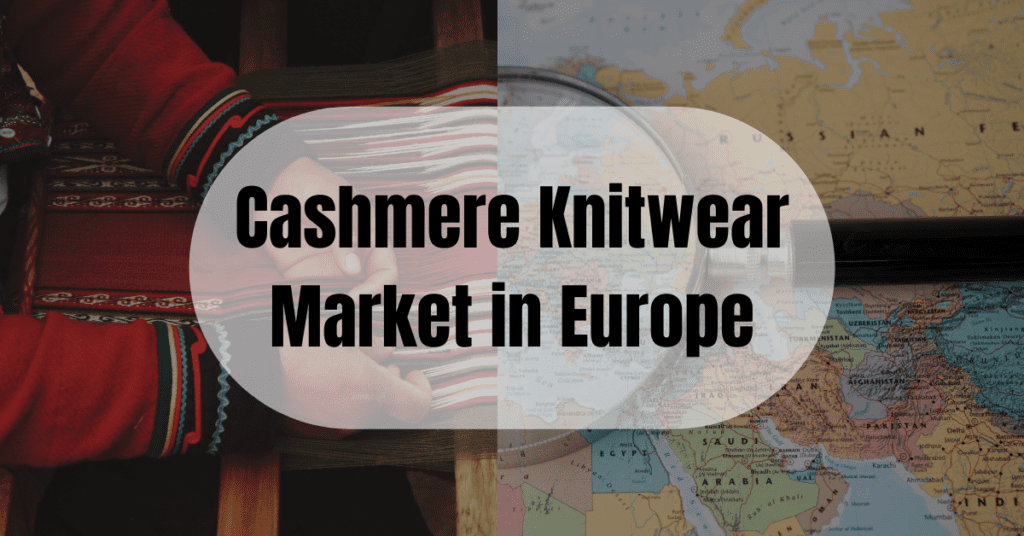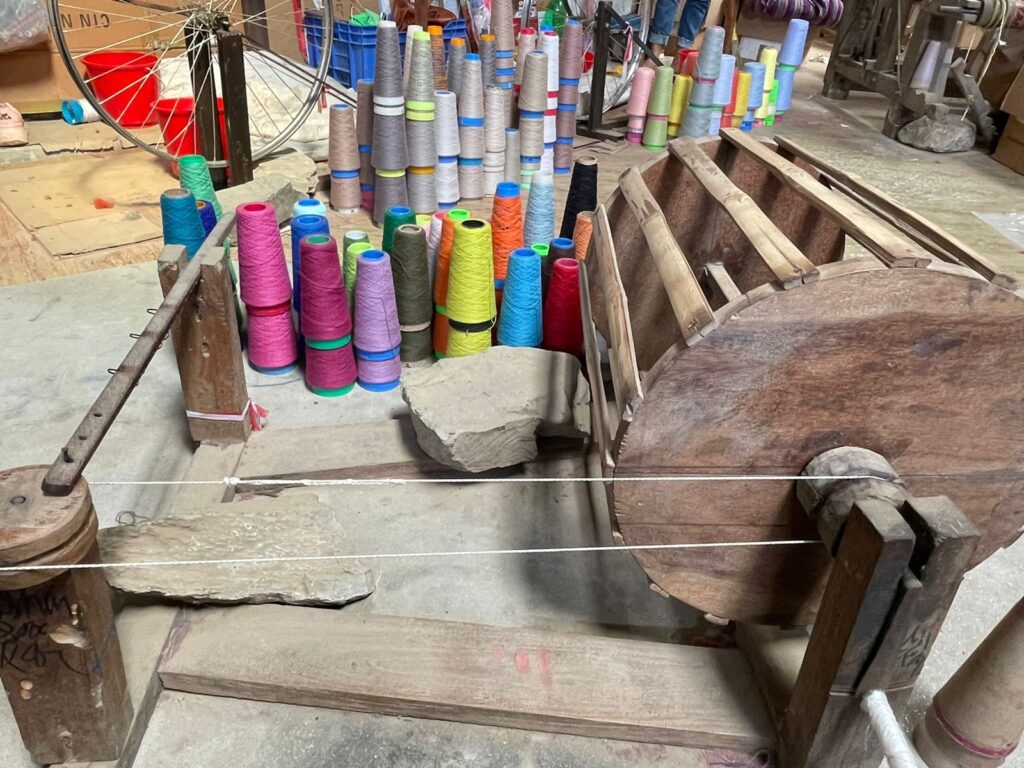The cashmere knitwear market in Europe is a significant sector within the overall textile and clothing industry. Cashmere is a luxury fiber known for its softness, warmth, and durability, and is highly sought after by consumers in Europe and around the world.
The demand for cashmere knitwear in Europe is influenced by a number of factors, including fashion trends, consumer preferences, and economic conditions. In recent years, there has been an increasing trend towards sustainable and ethically-produced fashion, which has led to a rise in demand for cashmere products that are sourced and produced in a responsible manner.
There are a number of countries in Europe that are major producers and exporters of cashmere knitwear, including Italy, Scotland, and Asian counties including Mongolia, Nepal, India, and China. These countries have a long history of producing high-quality cashmere products, and have established strong supply chains and expertise in the industry.
In terms of distribution, cashmere knitwear is sold through a variety of channels in Europe, including department stores, specialty boutiques, and online retailers. Many consumers in Europe are willing to pay a premium for high-quality cashmere products, making the market for these products relatively stable and lucrative.
Cashmere Knitwear Market in Europe

Europe is the most remunerative market for cashmere apparel and clothing worldwide. In 2022, the United Kingdom has the third highest revenue of cashmere knitwear apparel markets worldwide. This made it the highest earning clothing market in Europe.
Global knitwear market is anticipated to grow at an impressive rate due to the increasing adoption of e-commerce sites and expanding fashion industry.
Moreover, rising awareness about health and increased interest of consumer in appeal sustainability. Natural knitwear segments like Cashmere are expected to grow at a higher rate due to their anti-wrinkle, softness and high absorption capacity.
The Global Pure Cashmere 2021 market was valued at USD 2.66 billion in 2020 and is predicted to increase at a compound annual growth rate (CAGR) of CAGR from 2021 to 2027.
Demands Of Cashmere Products Europe
The demand for cashmere products in Europe is influenced by a number of factors, including fashion trends, consumer preferences, and economic conditions. Some of the key factors that drive demand for cashmere products in Europe include:
- Fashion trends: Cashmere is a luxurious and high-quality fiber, and is often featured in high-end fashion collections. As a result, the demand for cashmere products in Europe is influenced by fashion trends, with consumers seeking out the latest styles and designs.
- Consumer preferences: Many consumers in Europe value the softness, warmth, and durability of cashmere, and are willing to pay a premium for high-quality products. This has contributed to the ongoing demand for cashmere products in the region.
- Economic conditions: The demand for cashmere products in Europe is also influenced by economic conditions, with consumers being more likely to purchase high-end items during times of economic prosperity.
Overall, the demand for cashmere products in Europe has been relatively stable in recent years, with a trend towards sustainable and ethically-produced fashion helping to drive demand for these products.
In Europe mostly during the colder seasons cashmere sweater is the first choice in knitwear due to its warming and extremely soft nature.
Cashmere sweaters has become increasingly popular due to its comfort, ease of cleaning, versatility and suitability to the current fashion trends. You can read our previous blog on why cashmere sweaters is a better option than wool sweater.
Technique Used in Manufacturing of Cashmere Garments

People prefer to buy hand embellished over the machine embellished because of the strength, durability and uniqueness it encompasses.
Pure cashmere can be dyed and spun into yarns and knitted into jumpers (sweaters), gloves, socks and other clothing, or woven into
fabrics then cut and assembled into garments such as outer coats, jackets, trousers (pants), pajamas, scarves, blankets, and other items.
Row Material
Cashmere wool for clothing is obtained from the neck and underbelly region of cashmere goats. Cashmere goats produce a double fleece that consists of a fine, soft undercoat of hair. The hair mingled with a straighter and much coarser outer coating of hair, called guard hair.
For the fine undercoat to be sold and processed further, it must be de-haired, which is a mechanical process that separates the coarse hairs from the fine hair.
After dehairing, the resulting cashmere is ready to de-dyed and converted into textile yarn, fabrics and garments. The remaining long, coarse hair is typically clipped from the goats and is often used for brushes and non-apparel use.
We have our own design department. We have sampling facilities; to get a final product of choice.
Globally the most Potential Knitwear market, By Region:
- Europe
- Germany
- France
- United Kingdom
- Italy
- Spain
- Russia
- Poland
- Netherlands
- Luxembourg
Europe is the potential market for Cashmere knitwear, its imports are growing, due to its popularity during the colder seasons of the year. Cashmere knitwear can be used in innovate and creative ways, by layering it with other fabrics, using different fields of application. Cashmere knitwear has always been an important apparel segment for consumers in Europe.
Focus on the Top Six Markets
Germany, France, the United Kingdom, Italy, Spain and the Netherlands are the developed countries in Europe. These six countries export more apparels than other developed counties in Europe.
Because Europe has cold weather around the year only few month of summer, are the biggest importers of cashmere knitwear apparel. Majority of cashmere export from Mongolia, Nepal, India, etc.
Keep an eye on Europe’s fastest growing countries like Poland, Greece, Romania, Croatia, Hungary. These counties are also growing importers of cashmere/pashmina wool knitwear products.
The value of European knitwear imports originating from developing countries.
Imports from developing countries are growing faster than knitwear imports from within the European Union
Europe’s extra-European Union knitwear imports are dominated by Asian countries, with China, Bangladesh and Turkey being the top three exporters. Together, these three countries account for 40.7% of all knitwear imports into the European Union. Nepal is the emerging one.
Manufacturer of Cashmere Apparels
At OM Cashmeres, we understand the diverse preferences of the European market and are familiar with the types and qualities of knitwear that are in demand. As a manufacturer of cashmere knitwear clothing in Nepal, we keep abreast of global apparel trends, including those related to sustainability, technological innovation, and social responsibility.
The COVID-19 pandemic has had a significant impact on the fashion industry, with many consumers seeking out comfortable and stylish clothing options for working from home. During the winter months, cashmere knitwear products that combine comfort and chic have proven to be particularly popular.
Current fashion trends have also led to the emergence of new cashmere knitwear products, such as shift dresses, which have proven to be both comfortable and stylish. As a result, we are constantly seeking out new and innovative ways to meet the changing needs and preferences of our customers in the European market.
-
Product Innovation & Design
The cashmere knitwear market is constantly evolving, with new production methods and yarn treatments driving innovation in the industry. Recently, there has been a focus on technologies such as flat knitting, circular knitting for body-mapped garments, and warp knitting, which have been embraced by producers selling to the European market. These techniques were also the subject of discussion at recent industry conferences like ITMA.
Overall, the adoption of these new production methods and yarn treatments has the potential to revolutionize the cashmere knitwear market, offering consumers a wider range of high-quality, stylish, and innovative products to choose from. As the market continues to evolve, it will be interesting to see what other advances emerge in the coming years.
-
Marketing and Sales
Customers are looking for authenticity. Digital presence is the key element for customer impact. Customer experience is the most important thing. The quality of marketing is one of the key growth drivers in the E-commerce business.
-
Sustainability
At Om Cashmere, sustainability is at the heart of our brand and our products. We minimize our environmental impact and ensure that our raw materials, including yarn, are sourced in a fair and responsible manner..
To stay current with design trends in the cashmere knitwear fashion market, we closely observe market developments and are always looking for new ways to innovate and create interesting and highly valued designs. While we value our traditional knitting techniques, we are also open to learning and adopting new techniques to stay competitive and meet the needs of our customers.
Overall, our commitment to sustainability extends to every aspect of our business. From the sourcing of raw materials to the production of our final products. By prioritizing sustainability, we are able to create high-quality, stylish cashmere knitwear products that meet the needs and preferences of our customers while also protecting the environment.
Conclusion
At Om Cashmeres, our focus is on producing sustainable cashmere knitwear products for the global market. We understand the importance of sustainability to our buyers and have implemented eco-friendly production processes. We used sustainable cashmere yarn, and established traceability and recycling initiatives to meet these requirements.
It is essential for consumers to be able to trace the path of a product from raw material to the finished product. This transparency is a key element of our success. We work to ensure that our production meets the highest standards for quality, craftsmanship, and sustainability. We are committed to maintaining a sustainable and traceable production cycle from start to finish.
Contact Us